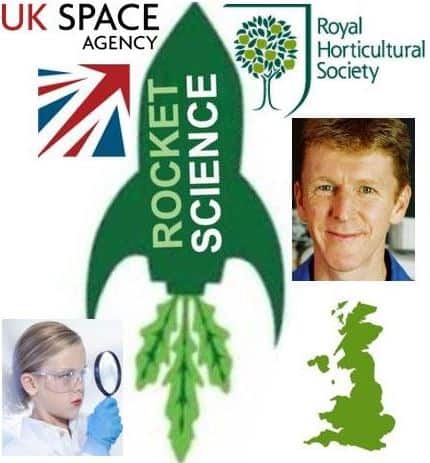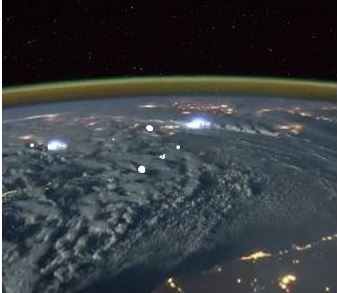A spectacular video of a lightning storm has been posted by British astronaut Major Tim Peake for all to see. During the lightning storm, which occurred over Turkey and North Africa, the time-lapse video footage shows several bright flashes appearing in rapid succession.
Major Tim Peake, who is currently aboard the International Space Station (ISS), which is in low orbit 250 miles from the Earth’s surface, posted the video on Twitter with the message “Amazing how much lightning can strike our planet in a short time.”
He was orbiting over North Africa towards Turkey and then Russia. From the ISS, the crew was able to see three continents – Africa, Europe and Asia – as it crossed the Mediterranean and the Black Sea.
Video of lightning storm taken from ISS
Amazing how much lightning can strike our planet in a short time #Principia #timelapsehttps://t.co/XijV5E1pI0
— Tim Peake (@astro_timpeake) February 9, 2016
The International Space Station (ISS) completes one full orbit of Earth every ninety minutes – it travels at 17,100 miles per hour (27,600 km/h) or 4.75 miles per second (7.66 km per second).
In January, Major Peake became the first British astronaut to do a spacewalk when he stepped out of ISS with NASA astronaut Tim Kopra to fix one of the solar power generators. They had to go back in early because Colonel Kopra’s helmet was leaking water.
Video of Aurora from space
The aurora, sometimes called polar light, is a natural light display in the sky, predominantly seen at the high latitude – Antarctic and Arctic – regions. In the northern hemisphere, the lights are called aurora borealis, and aurora australis in the southern hemisphere.
Major Peake also tweeted a video footage of an Aurora, which is visible above Earth’s horizon. We are fortunate that he enjoys sharing some of the wonderful spectacles he gets to witness up the in the weightless environment of space.
Small #aurora shows how thin our atmosphere is. #Principia #timelapsehttps://t.co/1PPRkUph8W
— Tim Peake (@astro_timpeake) February 10, 2016
Since boarding the ISS in December last year, Major Peake has shared some incredible photographs and videos of Earth and outer space with us. In fact, he is building quite a name for himself as a gifted space photographer.
He has also given us several behind-the-scenes glimpses and accounts of how astronauts do everyday things like going to the toilet, showering and preparing coffee.
Several experiments being done in space
Major Peake, who is tasked with conducting over thirty experiments for the European Space Agency, is scheduled to be back on Earth on 5th June, 2016.
His mission aboard ISS is called Principia, named after Isaac Newston’s Naturalis Principia Mathematica, an influential physics text.
Regarding Principia, Major Peake said:
“I am delighted with this name that honours one of Britain’s most famous scientists. I hope it will also encourage people to observe the world as if for the first time – just as Isaac Newton did.”
The Principia website says the following regarding the mission:
“The ISS is a unique scientific research facility, allowing Tim and his crewmates to work on experiments that cannot be done anywhere on Earth.”
“These experiments include physiology, biology, materials science, solar physics, radiation physics and technology demonstrations.”
 Major Peake tweeted this picture of London at midnight on a Saturday. Can you see the parks (dark patches) and the River Thames winding its way through the middle of the photograph? (Image: twitter.com/astro_timpeake)
Major Peake tweeted this picture of London at midnight on a Saturday. Can you see the parks (dark patches) and the River Thames winding its way through the middle of the photograph? (Image: twitter.com/astro_timpeake)
Tim Peake is the first European Space Agency astronaut, the six British-born person to visit ISS (Michel Foale of NASA was the first in 2003), and the 7th UK-born person to be in space – the first was Helen Sharman, who in 1991 visited Russia’s Mir space station.
In September 2009, he started ESA’s demanding astronaut basic training course, and graduated with flying colours in November 2010.
A massive space gardening project – Rocket Science
A massive space gardening experiment involving more than half-a-million British schoolchildren, major Peake, the UK Space Agency and the British Horticultural Society will soon be underway.
 Major Peake called on British kids to join him in the Rocket Science experiments, where they could become space biologists. (Image adapted from www.gov.uk)
Major Peake called on British kids to join him in the Rocket Science experiments, where they could become space biologists. (Image adapted from www.gov.uk)
Called Rocket Science, the aim will be to see how seeds grow in space compared to on Earth. Two kilograms of seeds were sent to ISS in September 2015, and will remain in its microgravity environment until March/April 2016.
In April they will be flown back to Earth and sent to thousands of schools across the UK.
Teams of teachers and pupils will plant the space seeds alongside seeds that remained on Earth. They will report on how well or badly the sprouting plants have grown to the UK Space Agency and the British Horticultural Society.
Space agencies worldwide – including NASA, Roscosmos and NASA – want to determine whether astronauts in deep space missions can grow their own food, and if so, how.
How do astronauts go to the toilet?
These are one of the questions we all think about but are too embarrassed or polite to ask, and one that children often ask when given the chance.
In January, Major Peake explained what a space toilet is like, how it works, and how it is used.
There are two separate pieces of equipment, which one is used depends on what the astronaut needs to do.
There is a toilet that looks very much like the ones we have in our homes. However, it uses suction to carry waste away rather than water. The solid waste is stored and disposed of later.
Urine, which is recycled, is collected in a separate container. The purified urine is processed and air for the crew to breathe is one of the products generated.
Video – How to use the loo in space

